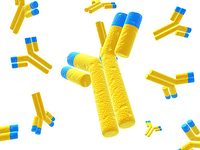How to we immobilize our antibody over a column to extract the antibody's specific antigen from different samples?

There are several activated resins available to achieve an affinity column.:
-
Sulfhydryl Coupling Resin: This resin uses an iodoacetyl group to covalently attach proteins to the resin through free sulfhydryls. Obviously for successful coupling free sulfhydryls must be present. In the case of antibodies, a mild reducing agent (2-mercaptoethylamine) can be used to generate free sulfhydryls in the constant domain, without destroying antigen binding affinities. The sulfyhydryl Immobilization kit for Proteins is supplied with all reagents to generate 5 x 2ml columns, including the reducing agent.
-
Amine Coupling Resin: The amine coupling resin has reactive aldehyde groups that react with primary amines to form Schiff’s bases. The Schiff’s base is then reduced with a suitable reducing agent (sodium cyanoborohydride) to form a covalent bond and couple the protein to the resin. A kit containing all the necessary reagents, including reducing agent is also available.
-
An alternative to the Amine Coupling Resin is NHS-Activated resin. This resin involves a reactive NHS group that binds to primary amines forming a covalent bond. The reaction is performed at near neutral pH and does not require a harsh reducing agent. A kit format is also available.
-
Immobilized Protein A, Immobilized Protein G or Immobilized Protein A/G. This bind the antibody constant domain ensuring the antigen binding domain are facing away from the resin for optimal binding. The selection is dependent of the affinity of the protein A, G or A/G for the antibody. Not a covalent attachment, unless a crosslinker is used, such as DSS. This however can affect affinity







